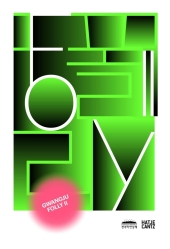 Neuerscheinungen 2013Stand: 2020-01-07 |
Schnellsuche
ISBN/Stichwort/Autor
|
Herderstraße 10
10625 Berlin
Tel.: 030 315 714 16
Fax 030 315 714 14
info@buchspektrum.de |

Nancy Adajania, Shumon Basar, Franco ´Bifo´ Berardi, Nikolaus von Hirsch, Philipp Misselwitz, Eui Young Chun
(Beteiligte)
Gwangju Folly II
Herausgegeben von Hirsch, Nikolaus von; Young Chun, Eui; Misselwitz, Philipp; Text: Adajania, Nancy; Basar, Shumon; Berardi, Franco ´Bifo´
2013. 244 S. 119 Abb. 240 mm
Verlag/Jahr: HATJE CANTZ VERLAG 2013
ISBN: 3-7757-3553-4 (3775735534)
Neue ISBN: 978-3-7757-3553-7 (9783775735537)
Preis und Lieferzeit: Bitte klicken
Mit Follies von David Adjaye & Taiye Selasi, Ai Weiwei, Rem Koolhaas & Ingo Niermann, Raqs Media Collective, Do-Ho Suh, Superflex, Eyal Weizman
Ursprünglich aus dem englischen Landschaftsgarten des 18. Jahrhunderts stammt der Bautypus der "Folly", wörtlich einer Narretei, also eines nicht ganz ernst gemeinten, häufig funktionslosen Zierbaus, der zumeist als Blickfang diente. Architekten, Künstler und Literaten nutzten Follies als frivole Staffage, als Orte der Satire und des Wahns außerhalb gesellschaftlicher Normen und Zwänge, aber auch als Medium für ihr Streben nach ästhetischer Autonomie und sozialpolitischer Veränderung. In die Stadt von heute transponiert, werden Follies zu Gradmessern für das Transformationspotenzial des öffentlichen Raums. Die Gwangju-Stiftung in Südkorea gibt international renommierten Architekten, Schriftstellern und Künstlern alljährlich dazu Gelegenheit. Der Band präsentiert die acht neuen Follies in Form eines Glossars und stellt die von Nikolaus Girsch, Philipp Misselwitz und Eui Young Chun kuratierten Projekte als "foolosophy" in einen umfassenden kulturellen Kontext.
Throughout history, follies have been used widely in architecture, visual arts, and literature as a provocation, a frivolous diversion or strategic place of madness and satire freed from the constraints of societal norms. Since their initial inception in landscape gardens, follies have been used as medium or object, oscillating between aesthetic autonomy and social-political potential. Placed in contemporary cities, follies become critical tools to test the constitution and transformative potential of public space. Revisiting some of these historic sites, a series of eight newly commissioned follies forge links between every day uses and political practice linking contemporary Gwangju and a global political arena. The book takes the form of a glossary, situating the eight new Follies within a broader cultural discourse and presents the projects curated by Nikolaus Hirsch, Philipp Misselwitz, and Eui Young Chun as foolosophy.
Nancy Adajania ist Kulturtheoretikerin und freie Kuratorin. Sie hat über die Themengebiete Neue Medien, transkulturelle Kunst und aufsteigende Künstler geschrieben und gelehrt.
Franco Berardi, aka Bifo, founder of the famous Radio Alice in Bologna and an important figure of the Italian Autonomia Movement, is a writer, media theorist, and media activist. He currently teaches Social History of the Media at the Accademia di Brera, Milan.


